
Knee arthroplasty is the gold standard treatment for endstage gonarthrosis and its volume is increasing constantly. The most important issue affecting the success of knee prosthesis is implants quality and biomechanical compatibility. In an ideal biomaterial, the elastic modulus should be close to the bone. This material also have to be wear and corrosion resistant and biocompatible. There are three components in a knee prosthesis design: femoral, tibial and patellar components. The tibial and femoral components consist of hard metal alloys such as cobalt-chromium, titanium and stainless steel. Intermediate structures that support the compatibility of these components and most patellar components are in polyethylene structure. Primary knee replacements are classified according to the preservation or sacrification of the posterior cruciate ligament and could be applied with or without cement. Polyethylene insert can be fixed or mobile. The use of ceramics, highflex designs, gender-specific prosthesis types, and especially tantalum-applied cementless prosthesis designs are increasing.